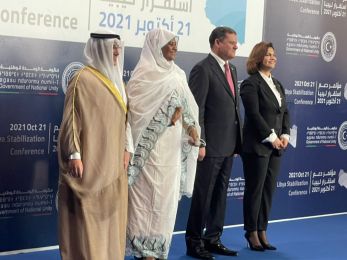VAO/T Z
Panafrican News Agency
IMF predicts recession in Zimbabwe for 2019
Harare, Zimbabwe (PANA) - The International Monetary Fund (IMF) has revised Zimbabwe's growth forecast downwards by a whopping 9 percentage points to -5,2% from 4,2% initially projected for 2019, predicting a recession for the country.
Driving the bad economic performance are depressed consumer spending reducing product demand, surging inflation, low foreign investment, foreign currency shortages, and drought-like conditions that will negatively affect the agricultural output for the current season.
Also, depressed global prices are affecting the exports of minerals as the main source of foreign currency and the lack of structural and political reforms is driving corruption costing over a billion dollars in yearly governmental revenue.
With weak expansion projected for important parts of the world, a realization of these downside risks could dramatically worsen the outlook. This would take place at a time when conventional monetary and fiscal space is limited as a policy response. It is therefore imperative that costly policy mistakes are avoided, the IMF's World Economic Outlook for April 2019, released on Wednesday read.
The IMF report follows recent comments made by the World Bank of Zimbabwe country chief economist, Marko Kwaramba, who said that the recent wanton increases in the prices of basic goods would affect the growth rate for 2019.
The downward IMF projection also comes in stark contrast to government's current projection of 3,1% growth for 2019.
As previously reported by Panapress, top United Nations experts warned last week that Zimbabwean government policies were worsening the country's economic crisis and causing immense hardship for the poor.
In October 2018, the government of Zimbabwe introduced austerity measures meant to address fiscal and monetary imbalances which has largely been blamed for the quickening of the economic downturn.
The main measures included a 2 percent money transfer tax and later in February the official reintroduction of a local currency, all of which has eroded the monetary values held by consumers
This is due to the tax making it more expensive to transfer funds as 90% of the country relies on these types of transactions and legislation supporting the local currency (RTGS dollars) basically preventing an upwards adjustment to salaries.
The lack of the upward adjustment to salaries comes despite business across each economic sector increasing their prices by at least three times in order to maintain 1:1 value against the greenback.
As a result, consumer spending has been decreased thus reducing demand and lowering the country's productivity efforts going forward.
Added to these challenges are the fiscal and monetary balances that have also had a negative impact on the economy.
In terms of the fiscal imbalances, this comes from high national budget deficits due to an increase in recurrent expenditure instead of productive spending. And for monetary imbalances, this comes from the country having electronic money five times more than the actual money to back it.
As of February 19, there was US$11 billion in electronic money backed by about US$2 billion in real hard cash, according to central bank statistics.
This particular imbalance has made it difficult to service imports of critical raw materials towards producing goods and enough backing to back depositor bank balances.
Lastly, with agriculture contributing 11% to the total gross domestic product (GDP) and being the main source of livelihoods for around 67% of the country's population, drought-like conditions have negatively affected crop production for the current season.
This has resulted in a huge proportion of temporarily and permanently wilted crops in the typically dry southern, eastern, western and extreme northern parts of Zimbabwe.
It is very simple and straight forward, it (IMF growth forecast) is related to the El Nino induced drought and the aftermath of Cyclone Idai.
Also, there is the role of the primary factors that have had an adverse effect on the economy and the shortages of foreign currency, Labour and Economic Development Research Institute of Zimbabwe (LEDRIZ) Director of the Godfrey Kanyenze said.
A lot of companies are closing as a result of the acute shortages of foreign currency. And in parliament, ICT companies were highlighting to parliamentarians that their operations were being affected by the lack of foreign currency.
Kanyenze added ,"these are just forecasts, predictions in terms of the weather, the foreign currency situation and reforms. He said structural reforms were also required.
"If you go to the IMF Article 4 report of 2017, it has got two scenarios. One based on business as usual where there are no reforms, you can call that the baseline scenario and another one based on a reform trajectory, Kanyeze said.
If you undertake successful reforms, ease of doing business, public and private sector reforms as have been mooted by the government then your scenario in terms of what will happen next year and the year after changes completely positively.
Under section B (14) of the IMF Article 4 report of 2017 report, it found that fiscal consolidation and structural reform would see the economy grow by an average of 5,9% per annum from now till 2022.
Absent the fiscal consolidation and reforms, sections (15) and (16), stated that there would be a decline by an average of -3,5% per annum till 2022.
ldquo;I think that the IMF has more accurately measured the capacity in the country now. The fact is that we have not done anything important in investing recently and we still have constraints on the amount of investments that actually take off now. We have got a scarcity of money and a scarcity of investors with the confidence to come here and so we have not attracted the investment capital that would overcome our liquidity problems.” Economist John Robertson said.
IMF's World Economic Outlook for April 2019 states that policymakers need to work cooperatively to help ensure that policy uncertainty doesnt weaken investment.
Fiscal policy will need to manage trade-offs between supporting demand and ensuring that public debt remains on a sustainable path, and the optimal mix will depend on country-specific circumstances.
Financial sector policies must address vulnerabilities proactively by deploying macroprudential tools. Low-income commodity exporters should diversify away from commodities given the subdued outlook for commodity prices. Monetary policy should remain data dependent, be well communicated, and ensure that inflation expectations remain anchored,” IMF's World Economic Outlook for April 2019 read.
The IMF outlook report found that reorienting spending toward infrastructure and social outlays, together with boosting domestic revenue mobilization by broadening the tax base and strengthening revenue administration, are crucial for growth of low-income economies.
While country circumstances differ, common policy areas help achieve this broad goal. These include sound macroeconomic management, ensuring broad-based labor force participation by lifting education quality and worker skills, reducing infrastructure shortfalls, boosting financial development and inclusion, and incentivizing the entry of firms and private investment (by strengthening property rights, contract enforcement, and reducing barriers to trade),” the IMF's World Economic Outlook for April 2019 read.
Low-income developing countries have also borne the brunt of climate change and potent natural disasters. Lowering the fallout from these events will require adaptation strategies that invest in climate-smart infrastructure, incorporate appropriate technologies and zoning regulations, and deploy well-targeted social safety nets.
-0- PANA TZ/VAO 10April2019
Tags Economy






